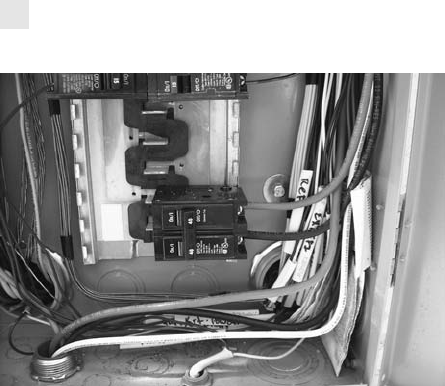
Working in an attic requires wearing
PPE, such as breathing mask, eye protection,
and clothing. PPE can protect the installer
from attic insulation.
Battery Safety
Many PV systems use batteries, or a device
that converts chemical energy directly into
electrical energy by means of an electro-
chemical reduction-oxidation (redox) reac-
tion. They are used primarily in PV systems
as backup power sources.
Hydrogen is lighter than oxygen. It is
also more volatile. Hydrogen gathers at the
top of the battery container during charging
and discharging. If the hydrogen concentra-
tion gets too high, it can become explosive.
Vent battery containers at the top. This allows the hydrogen to escape. According
to NEC 2011, Article 480.9(A), “all battery locations must provide ventilation.”
However, there is no guidance for that ventilation! Do not vent battery containers
on the bottom. Battery acid accumulates during charging, and discharge needs to
be properly contained.
Batteries store hundreds to thousands of amp hours chemically. A battery
short can cause a rapid discharge. Rapid discharge can cause the battery to
explode. The liquid spewed from the battery is corrosive.
Work carefully with and around batteries. Use electrically insulated tools.
Test the circuit at least three times to ensure safety. Use the appropriate PPE
around batteries. Be prepared to neutralize battery liquids with baking soda. Bat-
tery shorting can cause burns, fire, electrical shocks, and death.
Scope and Purpose of the NEC
Some local AHJs use regional electrical codes, but most use the NEC. The NEC
states its purpose as “practical safeguarding of persons and property from hazards
arising from the use of electricity” [90.1(A)].
The Code addresses nearly all types of PV power installations. It covers
standalone and grid-tied systems. The NEC does not cover PV installations in
automobiles, railway cars, or boats [90.2(B)]. It also does not cover micro-power
systems used in watches, calculators, or self-contained electronic equipment that
has no external electrical wiring or contacts.
The NEC deals with any PV system that has external wiring or electrical
components. You should institute safeguards so that untrained people do not
encounter exposed wiring and components.
As a PV installer, you will work with many different types of
electrical systems.
Courtesy of PerfectPower, Inc.
98 ADVANCED PHOTOVOLTAIC INSTALLATIONS
..................Content has been hidden....................
You can't read the all page of ebook, please click here login for view all page.
